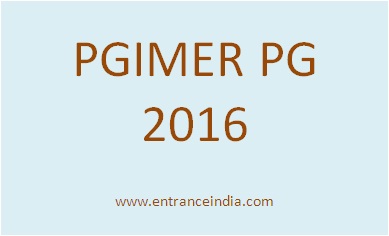 Candidates will be considered for selection to MD/MS courses based on a theory paper consisting of 250 multiple choice question (MCQs) with five alternatives each and single/multiple correct responses. Negative marks will be given for incorrect responses marked. The duration of this competitive entrance examination, to be conducted at various centres at Chandigarh is three hours.
Candidates will be considered for selection to MD/MS courses based on a theory paper consisting of 250 multiple choice question (MCQs) with five alternatives each and single/multiple correct responses. Negative marks will be given for incorrect responses marked. The duration of this competitive entrance examination, to be conducted at various centres at Chandigarh is three hours.
The approximate number of questions for each subject is as follows: Applied Anatomy – 6, Applied Biochemistry-12, Immunogenetics and Molecular Biology-10, Applied Physiology-6, Pathology – 15, Pharmacology – 12, Microbiology – 12, Forensic Medicine – 6, Social and Preventive Medicine-7, Internal Medicine-36, Paediatrics-12, Dermatology-6, Psychiatry-6, Radiodiagnosis-6, Obstetrics and Gynaecology-20, Radiotherapy – 6, General Surgery-36, Otorhinolaryngology -10, Ophthalmology – 10, and Orthopaedics – 10.
The question paper has 250 questions, each with five response options. Hence there are a total of 1250 response options. One or more of these five options can be correct for each question. The question paper therefore has some number of correct responses (say a) and incorrect responses (say b, such that a+b=1250). A candidate would mark a proportion of these responses as being correct. Some of these are truly correct (say x) while the remaining are wrongly marked as being correct (say y). The scoring is done through a customized software that matches the candidates’ responses to each of the 1250 possible responses (marked as correct, or left blank) with the true answer (correct or incorrect). True correct responses (i.e. candidate correctly marks a response as true) are scored positively, and incorrect responses (i.e. candidate marks an incorrect response as correct) are scored negatively. Any responses not marked by the candidate are not scored. A candidate’s percentage score will be computed using the formula: Percentage score= [x/a–y/b]×100.
As an example, assume that the question paper has 600 correct responses. If a candidate marks 580 responses as correct, out of which 450 are truly correct and the remaining 130 are incorrect, then a = 600, b = 650, x = 450 and y = 130. Accordingly, for this candidate, percentage score is: [(450/600) – (130/650)] × 100 = 55.0. Please note that these figures are only illustrative, and do not imply the actual number of correct responses in the question paper, or actual performance of any candidate.
Actual scores will not be considered further since these percentage scores will depend on relative difficulty of the question paper, and the relative ability of candidates, and it is not advisable to use these in generating cut-offs for selection. These will be converted into percentile score using the formula: Percentile= [(B+(0.5×E))/N]×100where B = number of scores below the candidate’s score, E = number of scores equal to the candidate’s score (1 if there is no tie, and >1 if there is a tie), and N = number of candidates appearing for exam. Overall rank of all the candidates shall be decided based on these percentile scores, with a higher percentile score translating into a better rank.
If two or more candidates obtain equal percentile scores, then inter-se merit for selection shall be determined on the following basis:
a) A candidate who has obtained higher aggregate marks in MBBS examination shall rank higher to a candidate who has obtained lower marks.
c) If the aggregate marks obtained in MBBS examination are the same, then a candidate senior in age shall rank higher to a candidate who is junior in age.
An overall merit list based on the percentile obtained by all the candidates appearing in the examination in the theory examination (irrespective of their category) will be prepared. Candidates of various categories who secure percentile in the theory examination, as mentioned against each category, will qualify for admission:
| Open (General) and Sponsored/Deputed | 55th percentile |
| OBC, OPH, SC/ST, Rural Area, Foreign Nationals | 50th percentile |
| Bhutanese Nationals | 45th percentile |
Candidates from reserved categories are also eligible to compete for general category seats (open category). Thus, in addition to category wise list, a combined General Category merit list of all the candidates will also be prepared.
Latest Govt Job & Exam Updates: